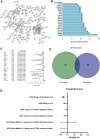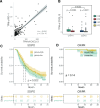Study on correlation between CXCL13 and prognosis and immune characteristics of ovarian cancer
- PMID: 39470479
- PMCID: PMC11521060
- DOI: 10.1097/MD.0000000000040272
Study on correlation between CXCL13 and prognosis and immune characteristics of ovarian cancer
Abstract
Ovarian cancer (OC) has a limited immunotherapeutic response; hence, this study aimed to investigate the relationship between CXC-chemokine ligand 13 (CXCL13) expression and overall survival (OS) rate, key immune pathways, degree of immune cell infiltration, and progressive disease (PD)-1 checkpoint blockade. A total of 703 differentially expressed genes were obtained from "The Cancer Genome Atlas" (TCGA) database based on the immune and stromal scores of 379 OC patients for getting the targeted gene CXCL13. The association between CXCL13 and OS in OC patients, biological function annotation of CXCL13, and its correlation with immune components were assessed. The results indicated that upregulated CXCL13 expression was positively correlated with better OC patient prognosis. CXCL13 expression was associated with 6 immune-related pathways, 10 immune cells, and PD-1 expression of OC micro-environment. Moreover, high expression of CXCL13 was related to a better tumor response and more extended tumor-stable stage after PD-1 blocking therapy in IMvigor210. The study concluded that CXCL13 could be a prognostic marker and a potential immunotherapy target for OC patients, especially PD-1 checkpoint blockade.
Copyright © 2024 the Author(s). Published by Wolters Kluwer Health, Inc.
Conflict of interest statement
All authors declare that they have no conflict of interests.
Figures









References
-
- Lheureux S, Gourley C, Vergote I, Oza AM. Epithelial ovarian cancer. Lancet. 2019;393:1240–53. - PubMed
MeSH terms
Substances
Grants and funding
LinkOut - more resources
Full Text Sources
Medical

